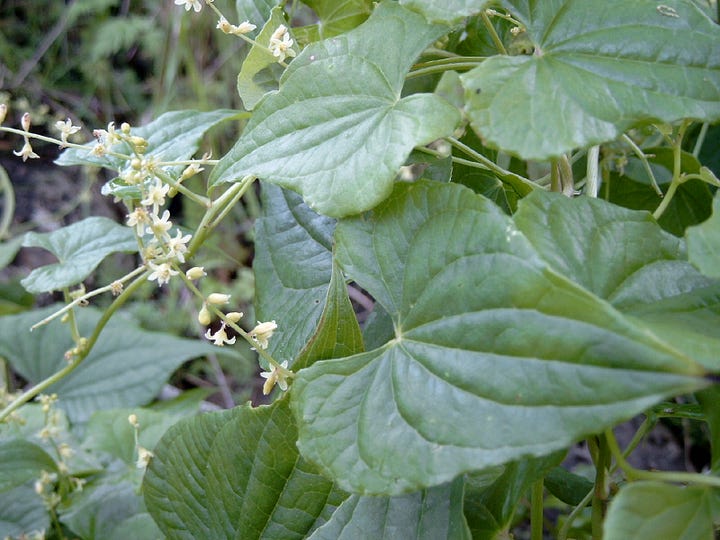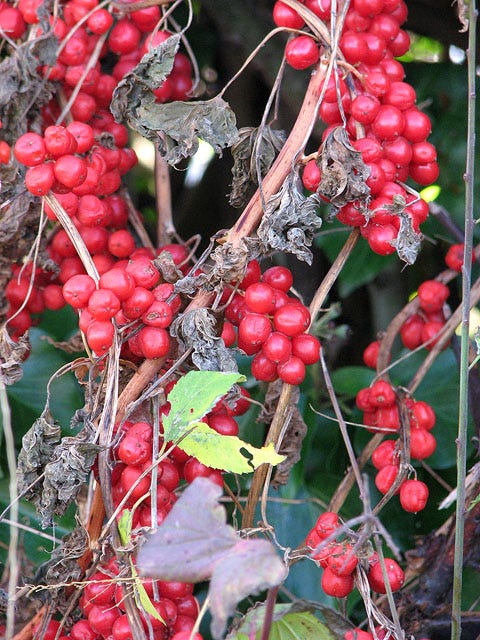In case you need reminding, please do your own research. I'm not responsible for what you choose to eat. Exercise caution
You’ll be familiar with the supermarket yam. These are a group of domesticated species within Dioscoreaceae family. They are known for their tasty tubers and need no further introduction.
What you might not know is that within the some 700+ species of this yam family lurks just one that thrives in the cold damp oceanic climate of the British Isles: Black Byrony, or Dioscorea communis.
This lesser known sibling is a vigorous perennial climber, producing lots of biomass, both above ground as leaves and below ground as roots and has beautiful jewel-like red berries.


As regular readers will know by now, I like to look at a plant and find out if it’s edible.
I’ve not poisoned myself yet though this might be a matter of time. I had a possible reaction to Chenopodium album for a few days but I won’t be sure until I try a few more times. Let’s see if I’m feeling crazy enough.
An online friend posted about Black Bryony, Dioscorea communis, recently. They said that the young leaves were sometimes eaten and sucker that I am, I dived down the internet rabbit hole.
I consulted
who confirmed that they used it in herbal medicine in Bulgaria and that it was thought to be poisonous or toxic when consumed.Most easily searched internet sources agreed with him, though a few didn’t. Digging deeper, I gradually discovered that I should look using the older name Tamus communis. Once I realised that a lot of interested parties hadn’t moved on with the taxonomic times I unearthed a lot more information.
The usual places like the Plants for a Future online database was a big tease, as usual, with its old inaccessible references. However, the presence of multiple references there referring to edibility gave me a cautious hope.
I eventually followed a literature breadcrumb trail to a wonderful text book called Mediterranean Wild Edible Plants by De Cortes Sánchez-Mata and M. Tardío.
Flicking through this book took me to page 436: a wonderful and probably the most complete monograph on Black Bryony anywhere. It’s even available as an ebook, brilliant!
The only snag? The whopping £120+ price tag you’ll have to stump up.
Assuming you pass this final barrier, I encourage you to read this book carefully. Really, a wealth of information of very underrated edible and medicinal plants.
Who controls the pricing on text books like these? This information deserves to be free!
Summary of the Monograph
Therefore, a summary of a summary, to help people discover more food sources:
Young shoots consumed as a type of wild asparagus in Mediterranean countries (Portugal, Spain, France, Italy, Slovenia, Bosnia-Herzegovina, Croatia, Freeze, Turkey, Palestine)
Collect in spring before flowering
Boil immediately after picking to remove bitterness (but not essential)
Traditional recipes:
Fried with eggs
Boiled with vinegar and served with oil and a boiled egg
Boil, then fry with garlic and olive oil
In risottos and tomato sauce
Cooking water reused to make potato stew or soup
Shoots fried with olive oil, chopped onion, paprika, minced garlic, parsley
Notes on Safety
The common safety feature is to always pick and consume the Black Bryony shoots when they are young and before it flowers, and bonus points if you boil the leaves before hand. Definitely do not eat the tubers or the berries. This isn’t the only edible plant with similar safety warnings (think potatoes when they are green, nettles after they flower).
I’ve not done the research but a trend I’ve noticed is that plants really don’t want to be messed with once they’ve put in the hard work of creating their reproductive parts, and the altered behaviour of animals undergoing their reproductive cycles tells me that this is probably universally true.
Why should you not eat the older and post-flowering shoots? Some poorly references internet sources talk about saponin content which is toxic but very poorly absorbed by the human body. Saponin is most famously found in Horse Chestnuts which in popular self-sufficiency circles is lauded as an easy way to make soap. The berries and roots contain high levels of calcium oxalate that can cause problems like kidney stones, though it is famously present in our humble domesticated spinach, rhubarb and others.
Final Thoughts
This article is a lesson in why knowledge shouldn’t be siloed. Luckily, check out the next section for a freely downloadable Spanish book by one of the same authors that seems to have similar material.
The question now, is, anyone brave enough to try cooking up some young Black Bryony shoots? I’m working on sourcing some so someone might beat me to the punch!
Until next time.
Further Reading
Black Bryony has been recorded as being eaten raw and cooked in Croatia
Black Bryony in risottos and pasta sauce
Mediterranean Wild Edible Plants by María de Cortes Sánchez-Mata, Javier Tardío containing on page 436 an excellent monograph on Black Bryony.
The whole book is available for stupid amount of money, but the important plant monographs can be downloaded separately at a lower price
If you can read Spanish or have an easy method of translation, I found a freely available older book by one of the authors that seems to have a similar monograph on Black Bryony. The page you’re looking for is 96. You’ll find more references in this book.
Wikipedia article contains a photo of harvest young shoots
Obligatory PFAF article with unobtainable references




I have a lot of bryony growing in the hedgerows around my field. Would you like me to send you some berries?
In this day and age of litigation and legal liability, it is difficult to share such information in an authoritative way. If someone else acts on your "advice" and runs into trouble then you might find yourself in a world of pain. Any thoughts on how to strategise/manage the risk of learning how to consume a potentially toxic plant? Common kidney beans can be deadly if not prepared properly, so this isnt unique to wild plants.